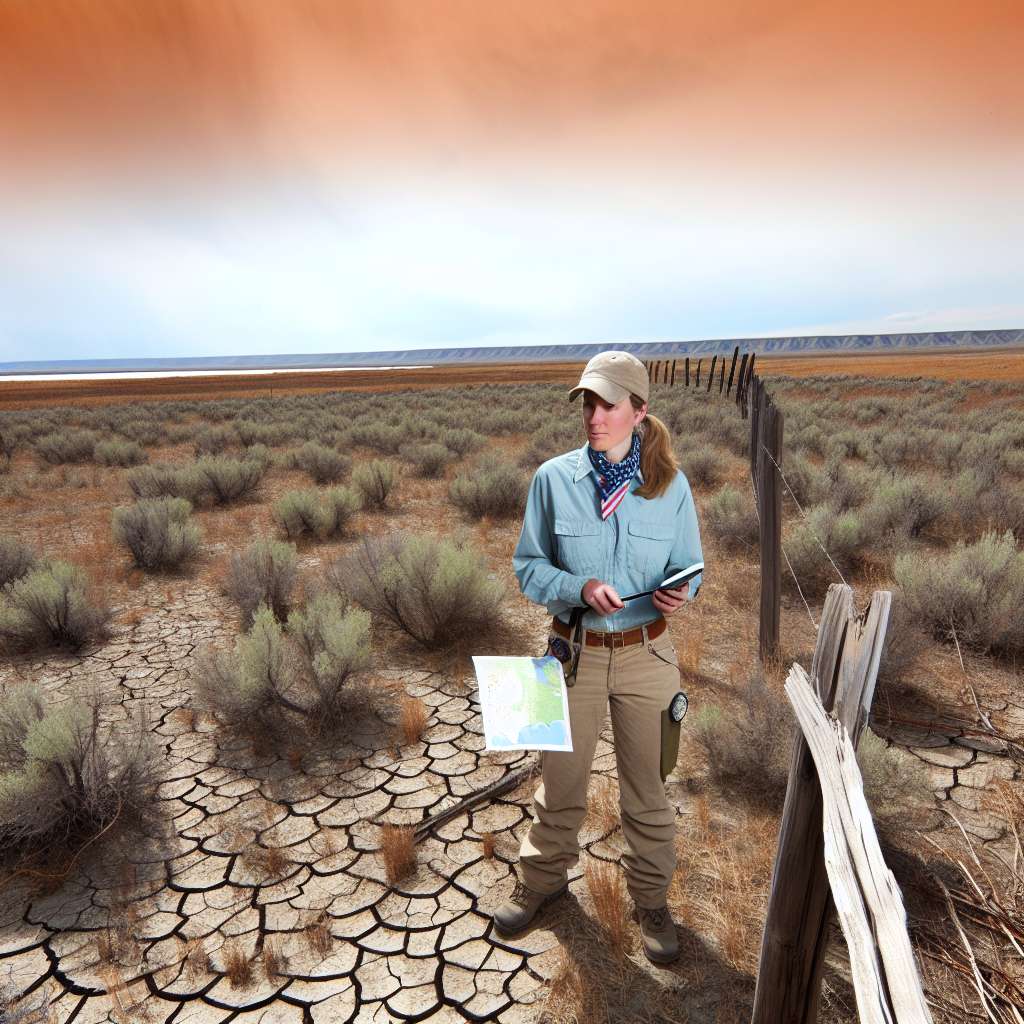Introduction:
Definition of Climate Change and its Impact on the Environment
Climate change refers to long-term changes in temperature and precipitation patterns.
These changes lead to disruptions in ecosystems.
Importance of Rangeland Management in the Face of Climate Change
Rangeland management plays a crucial role in adapting to climate change.
It involves implementing sustainable practices to maintain ecosystem resilience.
Preview of what will be covered in the blog post
This blog post will explore the effects of climate change on rangeland management.
We will discuss strategies for adaptation and the importance of sustainable practices.
Impact of Climate Change on Rangeland Ecosystems:
Changes in temperature and precipitation patterns directly impact rangeland ecosystems.
These changes can lead to alterations in plant composition and productivity.
Droughts and increased temperatures result in reduced forage availability for grazing animals.
Conversely, increased precipitation can result in overgrowth of invasive plant species.
Rangelands play a crucial role in carbon sequestration by storing atmospheric carbon in soil.
The degradation of rangelands can lead to the release of stored carbon back into the atmosphere.
This contributes to greenhouse gas emissions, exacerbating the effects of climate change.
Role of Rangelands in Carbon Sequestration and Greenhouse Gas Emissions:
Rangeland ecosystems act as important carbon sinks, offsetting greenhouse gas emissions.
Grasses and other vegetation in rangelands absorb carbon dioxide during photosynthesis.
This carbon is then stored in the soil, helping to mitigate the impacts of climate change.
Rangelands that are healthy and well-managed can sequester significant amounts of carbon.
However, degradation of rangelands through overgrazing or land conversion can release stored carbon.
This not only reduces the carbon sequestration capacity but also contributes to greenhouse gas emissions.
Transform Your Career Today
Unlock a personalized career strategy that drives real results. Get tailored advice and a roadmap designed just for you.
Start NowSpecific Changes Observed in Rangeland Ecosystems due to Climate Change:
Shifting precipitation patterns have led to changes in vegetation distribution across rangelands.
Some areas may experience increased droughts, affecting the growth of grasses and forbs.
Invasive species may outcompete native vegetation, altering the overall ecosystem dynamics.
Increased temperatures can also lead to changes in plant phenology and ecosystem productivity.
Wildlife that depend on rangelands for food and habitat may face challenges due to these changes.
Climate change poses a significant threat to the health and functioning of rangeland ecosystems.
Implementing sustainable rangeland management practices is crucial to adapt and mitigate the effects of climate change.
Challenges Faced by Rangeland Managers:
Adapting to climate change poses significant obstacles for rangeland managers.
Increased risk of wildfires due to hotter and drier conditions in rangelands.
Invasive species thrive in changing climates, complicating rangeland management.
Sustainable management practices are essential to mitigate these challenges effectively.
Find Out More: 4-H Youth Development: Collaboration and Impact
Exploring Innovative Approaches
Adapting rangeland management to changing climate conditions is crucial for sustainability.
Implementing rotational grazing techniques can help improve soil health and restore vegetation.
Integrating agroforestry practices can provide additional income streams and increase resilience.
Utilizing mobile technology for data collection and monitoring can enhance decision-making processes.
Incorporating indigenous knowledge and traditional land management practices can offer valuable insights.
Embracing holistic management principles can foster ecosystem health and biodiversity conservation.
Importance of Monitoring and Research
Monitoring climate variables and vegetation dynamics is essential for early intervention.
Showcase Your Business Today
Reach thousands of readers actively exploring professional services. Publish your business profile and grow your audience now.
Publish NowConducting research on climate impacts can inform responsive strategies and adaptation plans.
Collaborating with scientists and local stakeholders can enhance knowledge sharing and capacity building.
Establishing long-term monitoring programs can track changes and assess the effectiveness of interventions.
Investing in research on sustainable land management practices can lead to improved outcomes.
Promoting interdisciplinary research efforts can address complex challenges and find innovative solutions.
Examples of Successful Initiatives
- The Grazing Response Index tool helps ranchers make informed decisions based on weather conditions.
- The Sustainable Rangeland Roundtable brings together diverse stakeholders to discuss best practices.
- The LandPKS app allows users to assess land potential and plan sustainable rangeland management.
- The Soil Health Card program provides farmers with information to improve soil fertility and water retention.
- The Ecological Site Description system categorizes rangeland types to guide management decisions.
- The Pastoralist Knowledge Hub supports traditional knowledge exchange and sustainable land use.
Discover More: How Agricultural Technicians Assist Scientists
Importance of Sustainable Grazing Practices
Sustainable grazing practices help maintain the health and resilience of rangeland ecosystems.
Proper grazing management can enhance soil fertility and support diverse plant species, increasing carbon sequestration.
By using sustainable grazing practices, rangeland managers can minimize soil erosion and improve water infiltration rates.
Well-managed grazing can also reduce the spread of invasive species and protect native vegetation.
Role of Rotational Grazing and Rest Periods
Rotational grazing involves dividing rangeland into smaller pastures and rotating livestock between them.
This practice allows grazed areas to rest and recover, promoting the growth of nutritious forage for livestock.
Rest periods between grazing cycles are essential for rangeland health, as they allow vegetation to regenerate and soil to recover.
Rotational grazing and rest periods can help prevent overgrazing and maintain the ecological balance of rangeland ecosystems.
Role of Rangeland Managers
Rangeland managers play a crucial role in educating landowners and stakeholders about sustainable grazing practices.
They can provide technical assistance and guidance on implementing effective grazing management strategies.
Rangeland managers can develop grazing plans tailored to specific rangeland conditions and goals for sustainable management.
By promoting sustainable grazing practices, rangeland managers contribute to the long-term health and productivity of rangeland ecosystems.
You Might Also Like: 4-H Youth Agents: Connecting Youth to Agriculture

Restoring Degraded Rangelands:
Restoring degraded rangelands is crucial in the face of climate change.
It helps mitigate its effects.
Restoration of rangeland ecosystems is important.
It helps in enhancing biodiversity and ecosystem services.
One of the key benefits of restoring rangelands is the improvement of soil health and water retention.
- Improved soil health leads to increased vegetation cover.
- Increased water retention capacity of restored rangelands contributes to groundwater recharge.
Importance of Restoring Degraded Rangelands:
Restoring degraded rangelands plays a vital role in enhancing the resilience of ecosystems to climate change impacts.
Healthy rangelands are essential for supporting wildlife habitats.
They ensure the survival of various plant and animal species.
Restoration of rangeland ecosystems also helps in conserving native vegetation.
It promotes carbon sequestration.
Benefits of Restoring Rangeland Ecosystems:
- Enhanced biodiversity: Restoring rangelands promotes the recovery of native plant species.
- Improved ecosystem services: Healthy rangeland ecosystems provide essential services like carbon storage.
Examples of Successful Rangeland Restoration Projects:
The Loess Plateau project in China is a renowned example of successful rangeland restoration.
It has transformed degraded landscapes.
The project focused on implementing soil and water conservation measures.
It included reforestation and sustainable land management practices.
As a result, the restored rangelands have improved soil fertility.
They also increased vegetation cover and enhanced water availability.
- The success of the Loess Plateau project has benefitted local communities.
- It provided sustainable livelihood opportunities.
- Another example is the restoration efforts in the Great Plains of the United States.
- Grasslands have been revitalized through conservation practices.
Impact of Rangeland Restoration on Local Communities:
Restoring rangelands benefits the environment and local communities.
Healthy rangeland ecosystems support sustainable agriculture.
They also support livestock grazing and ecotourism activities.
These create economic opportunities.
Restoration projects often involve local communities in planning.
Showcase Your Business Today
Reach thousands of readers actively exploring professional services. Publish your business profile and grow your audience now.
Publish NowThis leads to increased community engagement and empowerment.
Learn More: Agricultural Loan Officer Interview Preparation
Building Resilient Rangeland Communities:
In today’s rapidly changing climate, rangeland communities are facing a multitude of challenges that are impacting their social and economic well-being.
Climate change has brought about extreme weather events, prolonged droughts, and shifting vegetation patterns, all of which have significant implications for rangeland management.
Social and Economic Implications
- Climate change is affecting the livelihoods of rangeland communities, who rely on these ecosystems for grazing livestock and other economic activities.
- Increased temperatures and changes in precipitation patterns can lead to reduced forage availability, negatively impacting livestock production and the overall economy of these communities.
- Extreme weather events, such as wildfires and floods, can destroy rangeland vegetation, leading to the loss of grazing lands and further exacerbating the economic challenges facing rangeland communities.
Building Resilience and Adaptive Capacity
- It is essential for rangeland communities to build resilience and adaptive capacity to effectively respond to the impacts of climate change.
- By adopting sustainable land management practices, such as rotational grazing and water conservation techniques, rangeland communities can enhance their resilience to climate variability.
- Investing in research and education programs that focus on climate-smart agriculture and rangeland management can help rangeland communities adapt to changing environmental conditions.
Role of Collaboration and Partnerships
- Collaboration and partnerships play a crucial role in creating climate-resilient rangeland communities.
- By working together with government agencies, NGOs, research institutions, and local stakeholders, rangeland communities can access resources and expertise needed to implement climate adaptation strategies.
- Engaging in participatory decision-making processes and involving community members in planning and implementation efforts can help build trust and foster a sense of ownership over resilience-building initiatives.
Building resilient rangeland communities requires a multi-faceted approach that addresses the social, economic, and environmental challenges posed by climate change.
Through concerted efforts and collaborative partnerships, rangeland communities can adapt to the changing climate and secure a sustainable future for generations to come.
Proactive Measures for Rangeland Management
After exploring the impacts of climate change on rangeland management, it is evident that proactive measures are crucial.
To ensure the sustainability of rangelands, it is imperative to implement climate-resilient practices.
By addressing the effects of climate change on rangelands, we can safeguard these ecosystems for future generations.
Taking action now will help mitigate the negative consequences of climate change on rangeland productivity and biodiversity.
It is essential for stakeholders to promote sustainable rangeland management practices that are resilient to climate change.
Encouraging the adoption of environmentally-friendly approaches can enhance rangeland health and productivity in the long run.
Proactive and sustainable rangeland management is key to mitigating the impacts of climate change.
It is crucial for individuals, communities, and policymakers to support climate-resilient practices to ensure the health and productivity of rangelands.
Additional Resources
Secretary Vilsack Announces Regional Hubs to Help Agriculture …
[E-Books for Sale]
The Big Book of 500 High-Paying Jobs in America: Unlock Your Earning Potential
$19.99 • 500 High-Paying Jobs • 330 pages
Explore 500 high-paying jobs in America and learn how to boost your career, earn more, and achieve success!
See All 500 High-Paying Jobs of this E-Book
1001 Professions Without a Degree: High-Paying American Jobs You Can Start Now
$19.99 • 1001 Professions Without a Degree • 174 pages
Discover 1001 high-paying jobs without a degree! Unlock career tips, skills, and success strategies for just $19.99!




